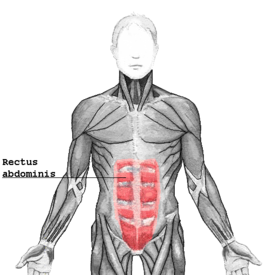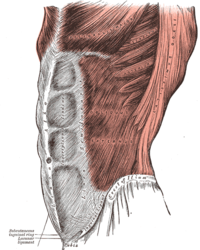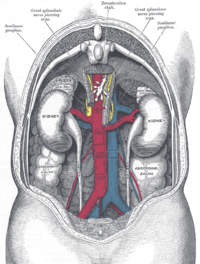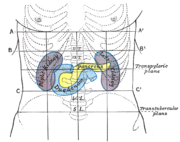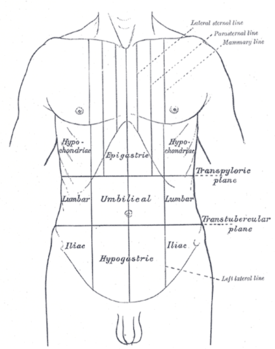Human abdomen
2008/9 Schools Wikipedia Selection. Related subjects: Health and medicine
The human abdomen (from the Latin word meaning "belly") is the part of the body between the pelvis and the thorax. Anatomically, the abdomen stretches from the thorax at the thoracic diaphragm to the pelvis at the pelvic brim. The pelvic brim stretches from the lumbosacral angle (the intervertebral disk between L5 and S1) to the pubic symphysis and is the edge of the pelvic inlet. The space above this inlet and under the thoracic diaphragm is termed the abdominal cavity. The boundary of the abdominal cavity is the abdominal wall in the front and the peritoneal surface at the rear.
Functionally, the human abdomen is where most of the alimentary tract is placed and so most of the absorption and digestion of food occurs here. The alimentary tract in the abdomen consists of the lower esophagus, the stomach, the duodenum, the jejunum, ileum, the cecum and the appendix, the ascending, transverse and descending colons, the sigmoid colon and the rectum. Other vital organs inside the abdomen include the liver, the kidneys, the pancreas and the spleen.
The abdominal wall is split into the posterior (back), lateral (sides) and anterior (front) walls.
Muscles of the abdominal wall
| Muscle | Origin and insertion |
| The obliquus externus ( external oblique) muscle is the outermost muscle covering the side of the abdomen. It is broad, flat, and irregularly quadrilateral. | It originates on the lower eight ribs, and then curves down and forward towards its insertion on the outer anterior crest of the ilium and (via the sheath of the rectus abdominis muscle) the midline linea alba. |
| The obliquus internus ( internal oblique) muscle is triangularly shaped and is smaller and thinner than the external oblique muscle that overlies it. | It originates from Poupart's ligament/ inguinal ligament and the inner anterior crest of the ilium. The lower two-thirds of it insert, in common with fibers of the external oblique and the underlying transversus abdominis, into the linea alba. The upper third inserts into the lower six ribs. |
| The transversus abdominis muscle is flat and triangular, with its fibers running horizontally. It lies between the internal oblique and the underlying transversalis fascia. | It originates from Poupart's ligament, the inner lip of the ilium, the lumbar fascia and the inner surface of the cartilages of the six lower ribs. It inserts into the linea alba behind the rectus abdominis. |
| The rectus abdominis muscles are long and flat. The muscle is crossed by three tendinous intersections called the linae transversae. The rectus abdominis is enclosed in a thick sheath formed, as described above, by fibers from each of the three muscles of the lateral abdominal wall. | They originate at the pubic bone, run up the abdomen on either side of the linea alba, and insert into the cartilages of the fifth, sixth, and seventh ribs. |
| The pyramidalis muscle is small and triangular. It is located in the lower abdomen in front of the rectus abdominis. | It originates at the pubic bone and is inserted into the linea alba half way up to the umbilicus. |
Abdominal organs
The abdomen contains most of the tubelike organs of the digestive tract, as well as several solid organs. Hollow abdominal organs include the stomach, the small intestine, and the colon with its attached appendix. Organs such as the liver, its attached gallbladder, and the pancreas function in close association with the digestive tract and communicate with it via ducts. The spleen, kidneys, and adrenal glands also lie within the abdomen, along with many blood vessels including the aorta and inferior vena cava. Anatomists may consider the urinary bladder, uterus, fallopian tubes, and ovaries as either abdominal organs or as pelvic organs. Finally, the abdomen contains an extensive membrane called the peritoneum. A fold of peritoneum may completely cover certain organs, whereas it may cover only one side of organs that usually lie closer to the abdominal wall. Anatomists call the latter type of organs retroperitoneal.
Surface landmarks of the anterior abdomen
In the mid-line a slight furrow extends from the ensiform cartilage/ xiphoid process above to the symphysis pubis below, representing the linea alba in the abdominal wall. At about its midpoint sits the umbilicus or navel. On each side of it the broad recti muscles stand out in muscular people. The outline of these muscles is interrupted by three or more transverse depressions indicating the lineae transversae. There is usually one about the ensiform cartilage, one at the umbilicus, and one between. It is the combination of the linea alba and the linea transversae which form the abdominal "six-pack" sought after by many people. A body fat of around 10% or below is required to see them.
The upper lateral limit of the abdomen is the subcostal margin formed by the cartilages of the false ribs (8, 9, 10) joining one another. The lower lateral limit is the anterior crest of the ilium and Poupart's ligament, which runs from the anterior superior spine of the ilium to the spine of the pubis. These lower limits are marked by visible grooves. Just above the pubic spines on either side are the external abdominal rings, which are openings in the muscular wall of the abdomen through which the spermatic cord emerges in the male, and through which an inguinal hernia may rupture.
One method by which the location of the abdominal contents can be appreciated is to draw three horizontal and two vertical lines.
Horizontal lines
- The highest of the former is the transpyloric line of C. Addison, which is situated half-way between the suprasternal notch and the top of the symphysis pubis, and often cuts the pyloric opening of the stomach an inch to the right of the mid-line. The hilum of each kidney is a little below it, while its left end approximately touches the lower limit of the spleen. It corresponds to the first lumbar vertebra behind.
- The second line is the subcostal line, drawn from the lowest point of the subcostal arch ( tenth rib). It corresponds to the upper part of the third lumbar vertebra, and it is an inch or so above the umbilicus. It indicates roughly the transverse colon, the lower ends of the kidneys, and the upper limit of the transverse (3rd) part of the duodenum.
- The third line is called the intertubercular line, and runs across between the two rough tubercles, which can be felt on the outer lip of the crest of the ilium about two and a half inches (60 mm) from the anterior superior spine. This line corresponds to the body of the fifth lumbar vertebra, and passes through or just above the ileo-caecal valve, where the small intestine joins the large.
Vertical lines
The two vertical or mid-Poupart lines are drawn from the point midway between the anterior superior spine and the pubic symphysis on each side, vertically upward to the costal margin.
- The right one is the most valuable, as the ileo-caecal valve is situated where it cuts the intertubercular line. The orifice of the vermiform appendix lies an inch lower, at McBurney's point. In its upper part, the vertical line meets the transpyloric line at the lower margin of the ribs, usually the ninth, and here the gallbladder is situated.
- The left mid-Poupart line corresponds in its upper three-quarters to the inner edge of the descending colon.
The right subcostal margin corresponds to the lower limit of the liver, while the right nipple is about half an inch above the upper limit of this viscus.
Regions of the abdomen
9-region scheme
These three horizontal and two vertical lines divide the abdomen into nine "regions." (Note that "hypo" means "below" and "epi" means "above", while "chond" means "cartilage" (in this case, the cartilage of the rib) and "gast" means stomach. The reversal of "left" and "right" is intentional, because the anatomical designations reflect the position on the patient. )
| right hypochondriac/ hypochondrium | epigastric/ epigastrium | left hypochondriac/hypochondrium |
| right lumbar/ flank/ latus/lateral | umbilical | left lumbar/flank/lateral |
| right inguinal/ iliac | hypogastric/ pubic | left inguinal/iliac |
4-region scheme
Another way of dividing the abdomen is by using 4 quadrants:
| right upper quadrant (RUQ) | left upper quadrant (LUQ) |
| right lower quadrant (RLQ) | left lower quadrant (LLQ) |
